The reefer Container ships of the AUSTRRALIAN VENTURE class
Guest Article

Christina Wagner
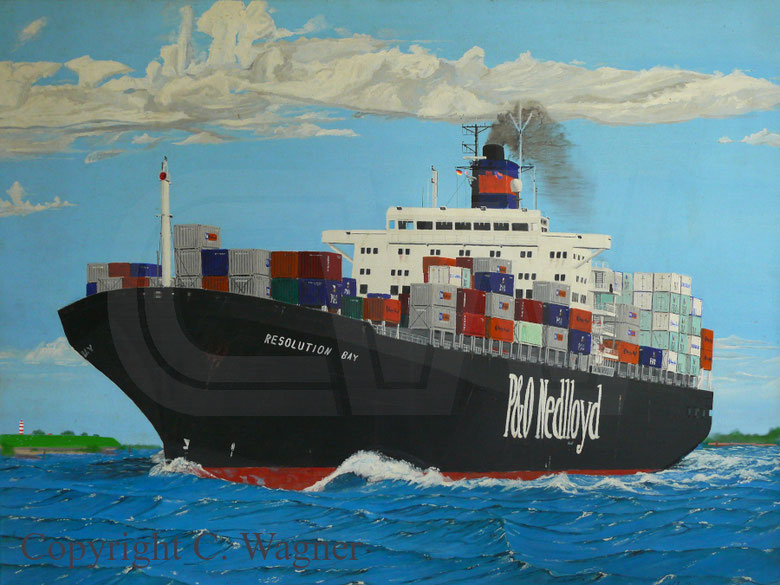
I painted the picture of RESOLUTION BAY more for personal reasons. As chance would have it, I got into conversation with a British sailor in Hamburg. He was an engineer on the sister ship PALLISER BAY. A friendship was formed that allowed us to meet again in the course of the voyages. So the ships took on a personal meaning for me.

When I talk about the ships now, you might think they are just normal container ships. But because of their history and use, they were more.
Containerisation, which began at the end of the 1960s, was supposed to revolutionise transport. The standardised "box" was supposed to drastically shrink the berthing times in the ports. Although
container ships handled many times more cargo, they only needed one or two days, compared to the long lay times of general cargo ships.
While at the same time general cargo ships with 12,000 t, which had previously been considered the "non plus ultra", were still calling, the size of container ships had already grown to over
40,000 t by the early 1970s. But the ships were to set new standards not only in terms of size, but also in terms of speed. Speeds of 23 knots, up to over 30 knots, underlined the speed of the
new "container" system.
However, the 2nd and 3rd generation ships, usually equipped with steam turbines, sometimes also with gas turbines, were quickly caught up by the oil crisis and sharply rising fuel prices.
The first container ships in the Europe-Australia service (1969), the ENCOUNTER class of Oversea Container Limited (OCL), were also equipped with steam turbines. The six ships, 213 m
long, 29,100 t and 1,510 TEU deadweight, reached 22 knots with their 23,867 kW (32,350 hp). The MELBOURNE EXPRESS and SYDNEY EXPRESS (Europe-Australia service), built in 1970
for Hapag-Lloyd, were also equipped with steam turbines. In some cases, as with the ENCOUNTER class, the steam turbines were later replaced by diesel engines. Other ships, such as
Hapag-Lloyd's first ships of the 3rd generation, were converted from a twin-screw to a single-screw ship with half engine power.

After the first years full of enthusiasm, it was clear that the future would not belong to the steam turbine. When some shipping companies decided to build new container ships in the mid-1970s, they were to introduce a change in propulsion. Instead of steam turbines, the ships were to be fitted with more economical diesel engines. The engine manufacturers, such as MAN and SULZER, had reacted and developed powerful diesel engines. From 1977 onwards, a number of new container ships came into service. Among them, to name a few, were the 1,758 TEU container ships of the "STUTTGART class" built for Hapag-Lloyd by the Flender shipyard, Lübeck. AG Weser, Bremen, built two 2,436 TEU container ships, type TABLE BAY, for the Europe-Africa Service. HDW, Kiel, built the 2,434 TEU containership TRANSVALL ordered by Deutsche Afrika-Linien. The quartet of 2,450 TEU ships of the well-known S.A. HELDERBERG class was built at French shipyards.
The Australian Ventrure Class
The former Bremer Vulkan shipyard (bankrupt in 1997) received an order in 1974 from the Australian National Line (ANL), Associated Container Transportation (ACT), OCL and Shipping Coporation of
New Zealand to build five reefer container ships for the Europe-Australia service.
From 1977 onwards, the ships of the so-called AUSTRALIA VENTURE class thus came into service. They were among the first large container ships with diesel engines.
AUSTRALIAN VENTURE
On 28 February 1977, the first ship, the AUSTRALIAN VENTURE, which was laid down in October 1976 with construction number 1004, was delivered to ANL. With a length of 248.60 m, a breadth
of 32.21 m, a draught of 12.03 m, a DWT of 38,600 t, the type ship had a container capacity of 1,823 TEU. Through conversions, the possible container positions on deck were later increased on all
ships so that 2,344 TEU could be carried. With their capacity of 1,223 TEU for reefer containers, they were the largest reefer container ships in the world for a long time. The containers could
be carried in the holds at -23 degrees, in hold 8 also at -29 degrees.
As a twin-screw ship, with two five-bladed propellers whose diameter was 6.30 m, it was powered, like her sister ships, by two MAN K8 SZ 90/160A diesel engines. With a piston diameter of 90 cm, a piston stroke of 1.60 m and with up to 122 rpm, they produced a power of 19,595 kW (26,642 hp) each. With a combined 39,190 kW (53,284 hp), it reached a speed of up to 24 knots.

The ship was sold to the Swiss company Meditarranean Shipping Cpmpany (MSC) in 1996. There it was given the name MSC NURIA. Now deployed on other routes, she parted ways with her
sister ships. On 24 December 2006, she was the last ship of this series of five to be scrapped.
ACT 7 / PALLISER BAY
On 24 June 1977, the sister ship ACT 7 followed with the construction number 1005. After the ACT consortium formed by various British shipping companies was dissolved in 1991, the
ACT 7 switched to P&O Containers. Since 1987, the well-known funnel coulor brand OCL had given way to that of P&O Containers. In 1986, P&O had taken over the remaining shares
of its previous partners in OCL and renamed it P&O Containers in 1987. Renamed PALLISER BAY, she continued to sail for some time in her former light grey livery with P&O funnel
mark. Then she was given the blue livery customary for P&O container ships. In 1996, P&O and the Dutch NEDLLOYD formed the P&O NEDLLOYD. Now the ship received a black hull with and a
new funnel colour.



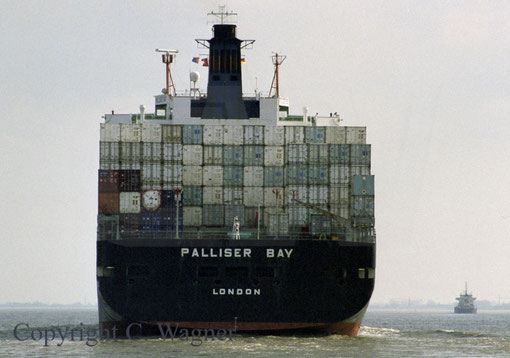
RESOLUTION BAY / MAIRANGI BAY
The RESOLUTION BAY was launched for OCL on 01 October 1977 under construction number 1006. She was followed by the identical MAIRANGI BAY on 28 April 1978. Even though they can
be regarded as sister ships of the two previous vessels, they differed mainly in the superstructure. The radar units, which had previously been installed separately, were combined in one radar
mast. After being painted green/white, then green only, they also sailed in these colours initially under the P&O brand until they finally received the blue paint. Like the PALLISER
BAY, they changed to the P&O Nedlloyd colours in 1996.


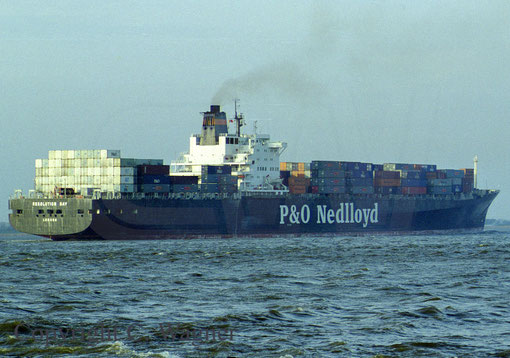

NEW ZEALAND PACIFIC
The last ship of the five-ship series to be delivered was the NEW ZEALAND PACIFIC on 20 September 1978 with the construction number 1008. The ship, built for Shippimg Corpration Nwe
Zealand, was painted a striking red. The deckhouse of this ship differs from the previous ships in that the mess areas are spread over two decks. In 1989, the ship was sold to Fuday Ltd, Hong
Kong, and was briefly given the name TUI. In the same year she joined ACT, again as NEW ZEALAND PACIFIC. After their dissolution, she changed to P&O Containers. In
contrast to the other ships, she kept her hull colour until the demolition in 2002. Until the change to P&O Nedlloyd, she also still sailed with the old funnel colours.
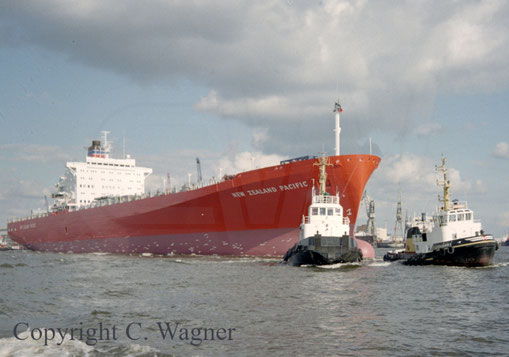


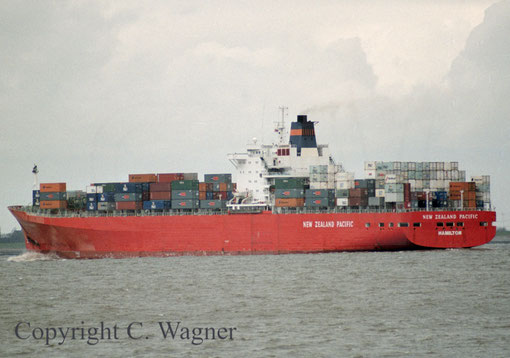
FAREWELL RESOLUTION BAY
On 9 July 2002, the RESOLUTION BAY presented herself for the last time on the Elbe in picture-book weather, in the morning sunshine. Her journey took her to China, where the scrappers were
waiting for her.
She said goodbye with the usual plume of smoke and oversized British flag at the stern.
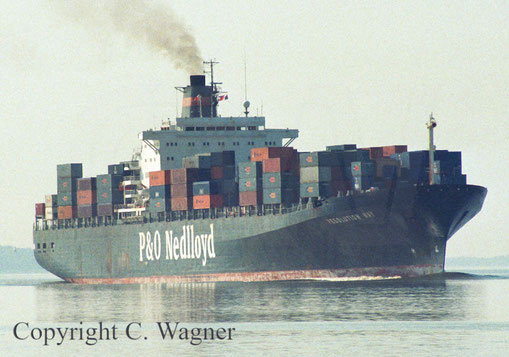

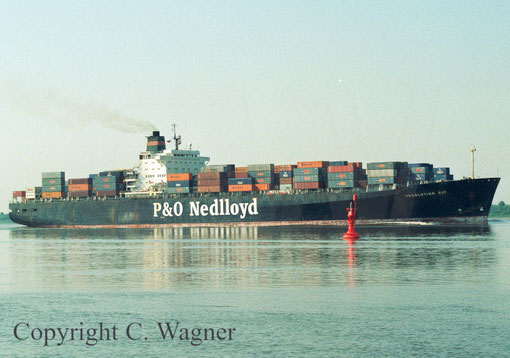

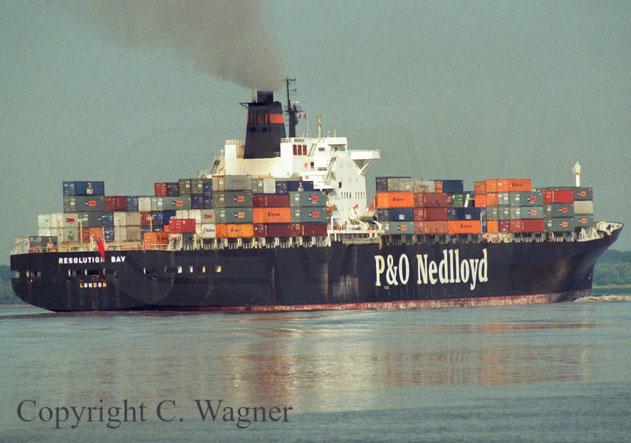
LAST CALL NEW ZEALAND PACIFIC
On 3 September 2002 it was also goodbye NEW ZEALAND PACIFIC. With her, the last ship of the quartet deployed by P&O Nedlloyd on the Europe-Australia
route said goodbye.
On her departure from Hamburg, she was also accompanied by sunny weather on her last voyage on the Elbe.


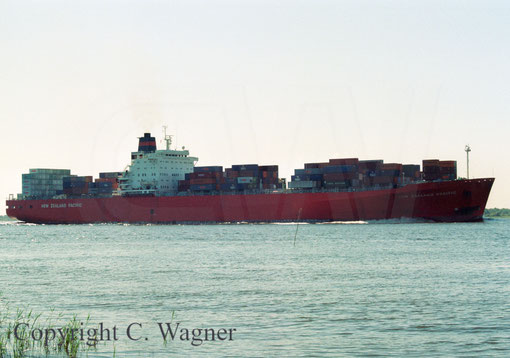

On 7 June 2002, the dismantling of the MAIRANGI BAY began in Jiangyin (China). She was followed by the PALLISER BAY in July 2002. In September, the RESOLUTION BAY
arrived in Jiangyin. The last ship to arrive in China was the NEW ZEALAND PACIFIC on 11 November 2002.
With the scrapping of the MSC NUIRA, ex AUSTRALIA VENTURE, 2006 in Chittagong, Bangladesh, the history of this series of ships came to an end.
THE NEW SHIPS
P&O Nedlloyd used SANTA R-class ships from the Hamburg shipping company Claus-Peter Offen as replacements. The shipping company had ordered seven ships from Samsung Heavy Industries (South
Korea), all of which were delivered in 2002.
The 281 m long, 32.20 m wide ships have slots for 4,400 TEU. Of these, 1,300 TEU are available for integral refrigerated containers. With a Samsung-Sulzer 9RTA 96C-B with an output of 51,485 kW
(70,000 hp), the ships run up to 24.5 knots.
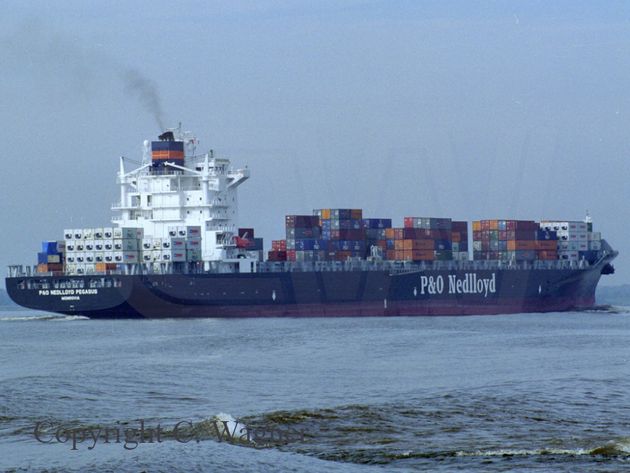
P&O Nedlloyd took over the charters for all seven ships in 2002 and operated them on various routes, including the Europe-Australia service. In 2006, after the takeover of the shipping company by the Danish Maersk shipping company, the ships were renamed, but initially remained with Maersk. Currently, all ships sail for MSC.
